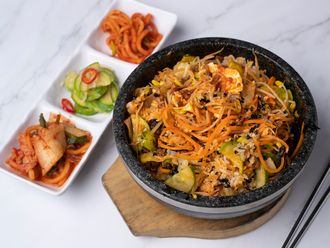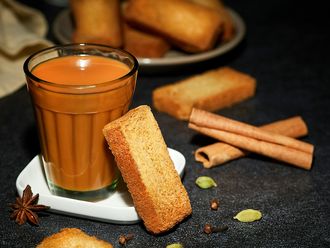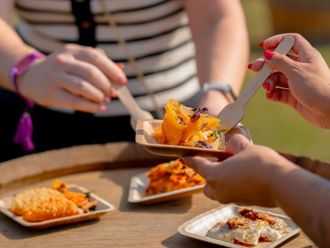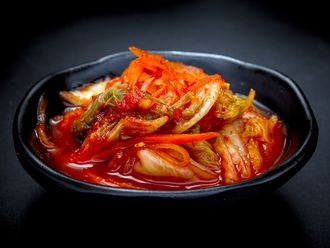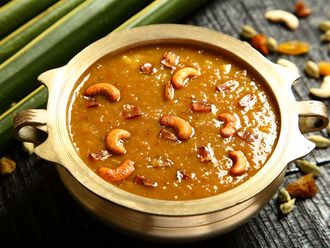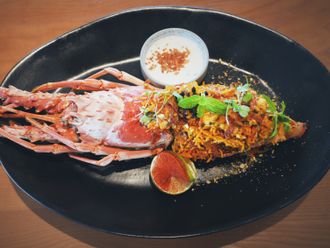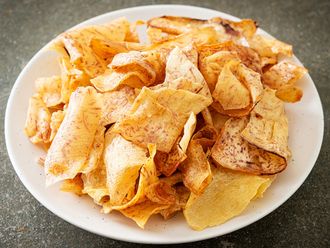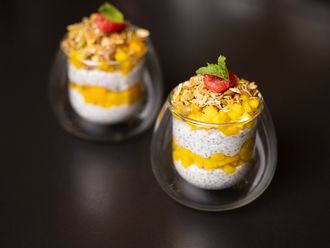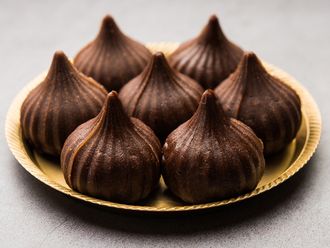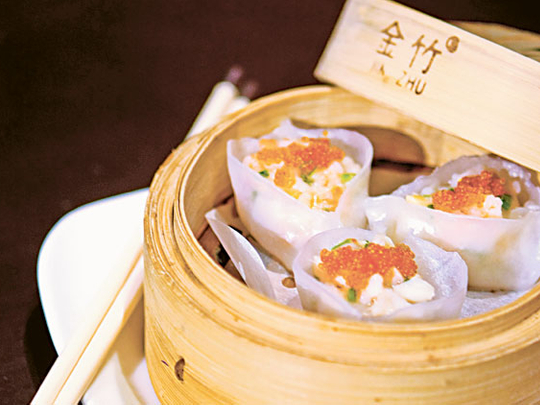
The Chinese New Year, like any festival, has many traditions but there is one way of celebrating in particular that is very important: gifting red paper packages stuffed with cash. It's a way of hoping the rest of the year is as fruitful as that day. While that's something one billion people will be doing with fervour come January 23, there's a way you can join in the celebration with your own little packages stuffed with loveliness — in this case, we're talking about Chinese dumplings.
The dough-wrapped pouches of meat, seafood or vegetables form part of a meal called dim sum — a selection of steamed and fried little portions served with tea (in Hong Kong, it's known as yum cha, or drink tea). Although dumplings are not specifically a new year's dish (that's the Yu Sheng salad, right), being as popular here as they are in the mainland, they're a good way to make something authentic and easy. While some dim sum items are intricate and complicated to make, our mixed seafood dumplings are simple and fun for all the family to make, and a delight to eat.
"It's an easy dumpling for people to make at home," said Jef Low, the Malaysian-Chinese executive chef at the Mall of the Emirates outpost of Chinese eatery Chi'Zen. "You can also use any meat or vegetables you like in the filling, to suit your taste."
The mouth-watering dumplings start with a silky dough based on three simple ingredients — wheat flour, potato flour and boiling water. "The wheat flour makes it strong, and the potato flour makes it stretchy," said Low, as he mixed together the flours after adding water that he boiled in a matter of seconds on the fierce wok burner in his restaurant kitchen. At first the dough appeared crumbly and dry, but after turning it out on to a board and kneading for about three minutes, the crumbs came together into a springy, bouncy ball of warm, white dough. You can knead and knead — unlike pastry, it won't be too damaged by overworking, but do make sure to pop it in a plastic bag to prevent it from drying out and make it as you need it. "You can't make it in advance," Low said. "We make it every morning for the lunch service and every afternoon for the evening. Don't try to freeze it either. The dough will disintegrate as it steams." Luckily it's such a quick dough to make — you won't spend more than 15 minutes on it — that it's easily made in time for dinner.
Low lets his colleague, Xia Tong Hong, take over to turn the lump of dough into thin dumpling skins. Oiling his wooden board, he rolls half the dough into a thick sausage about 2cm in diameter, then cuts off chunks about 1.5cm wide. He flattened it into a disk with his palm, then battered it into a perfect circle about 3mm thick and 6cm wide before using the cleaver to loosen the skin from the board. "You can use a rolling pin too," chuckled Low as I made an attempt at the cleaver-flattening method. With a bit of practice it's do-able, but not something I'll probably repeat at home. Just use a dab of oil rather than flour to prevent sticking, if needed.
The filling, unlike the dough, can easily be made in advance and flavoured to your liking, although Low's classic combination of prawn, scallop, white fish, spring onion, coriander and sesame oil can't be beaten in my opinion. Cut seafood into very small chunks, but don't overmince it or it will be rubbery. Add the seasoning and a dust of cornflour to bind; it can be made the night before, Low said.
Filling the dumplings, which are actually open, is child's play (it's a fun and safe activity for the kids, in fact). Low put a heaped tablespoon of filling into the centre of the skin, then pinched on two sides to enclose the filling like a little boat. He folded over the points one more time to seal, before setting it on the table to ensure the dumpling has a flat bottom and can stand upright.
"The mix will stick to the dough automatically," Low said. They go into a simple bamboo steamer lined with greaseproof paper (poke some holes in the bottom) and are steamed over a pot of boiling water for five minutes before being topped with a pretty but optional orange spoonful of tobiko, or flying-fish roe.
"It doesn't need any sauce," Low said, warning off those who like to fully dunk their dumplings in soy sauce.
After tasting, he's right — not only are they well seasoned, but the mix, in steaming, has created a tiny mouthful of its own soup inside the dough — moistening everything perfectly and surprising the eater in the process.
As we ate the finished dumplings over a pot of tea ("It's yum cha!" Low said gleefully) he explained what a typical Chinese New Year celebration entailed for his Chinese-origin family. "It starts at midnight on the 22nd, so just before that you get washed and ready, because you are not going to sleep for the next two days," he said.
"From midnight, we are up all night, watching fireworks and celebrating. On New Year's Day, we visit our grandparents to give packages. We only eat vegetarian food on this day. Finally, we might get some sleep at the end of that day, then the next we eat a huge feast, usually cooked by my mother, where we have meat. The celebrations continue for 15 days in total."
Mixed seafood dumplings
For the dough
- 50g wheat flour
- 30g potato flour
- 1/4-1/2 cup boiling water
- Vegetable oil for greasing
For the filling
- 20g white fish fillet
- 50g prawn
- 20g scallop
- 20g celery, chopped
- 20g carrot, chopped
- 5g fresh coriander
- 1 tsp chicken powder
- A pinch of salt
- Large pinch of sugar
- 1 tsp sesame oil
- A pinch of white pepper
- 1 tbs tobiko (also known as flying-fish roe, sold in Asian markets and some supermarkets in the fish chiller)
Wash all the seafood and pat dry with paper towel.
Place the seafood, celery, carrot, coriander, chicken powder, salt, sugar, sesame oil and white pepper in a food blender. Mix until all the ingredients are bound together and minced up. The seafood should be around 1/2cm in size. Do not over blend.
Mix wheat flour and potato flour with enough boiling water to form smooth dough. It should be dry and crumbly at first. Add more water if needed. Cut the mix into three even pieces.
Roll out into even, thin circles.
Place a tablespoon of the seafood mix in the centre of the circle. Carefully bring the sides of the dough up around the mix. The mix will stick to the dough automatically. Place the dumplings into steamer basket bottom lined with greaseproof paper.
In a pan add about one and a half inches of water and bring to the boil.
When the water is boiling, place the basket on top and cover with the lid. Cook for five minutes until the mix is cooked through and firm to the touch.
When cooked, remove from the heat and garnish each dumpling with a little of the tobiko and serve.



